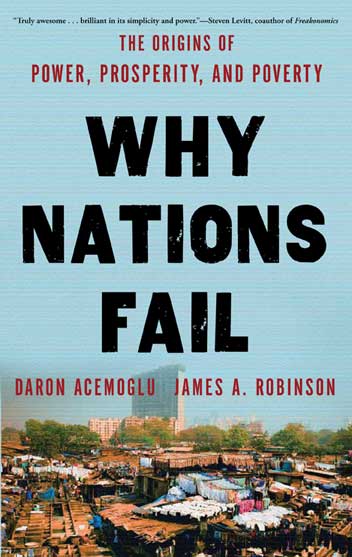Why Nations Fail by Daron Acemoğlu and James A. Robinson

Summary
In this book, Daron Acemoğlu and James A. Robinson explained their theory about what makes some countries in the world more successful than others nowadays. They try to understand the underlying causes of the different current dynamics of development and how they take root in past events. Over the chapters they develop a lot of historical examples from all known periods of history. Whether you agree or not with the theory they develop the book is really instructive thanks to these examples and some mentions about other existing theories about the topic.
Main points
Theory
The theory of Acemoğlu and Robinson is base on the fact that some political institutions create the right conditions in a country for the whole society to thrive while others prevent these conditions. The first type are inclusive institutions, they allow everyone to take part in the economy and get rewarded for it, either through a kind of “regular” salary or through a visible increase of income and quality of life for the most successful. The way it is describe really roots it in the liberal views. One key benefit of these institutions is that they encourage creative destruction, which is often seen as an unavoidable condition for innovation and so sustainable growth. Indeed, according to the authors, without innovation growth can’t be sustained over a long period of time.
The second type of systems mentioned are extractive institutions, they usually put in place economies where most of the benefits go only to a few selected people (usually the leaders of these countries). These people can then use the power and wealth to reinforce their position and create a vicious circle form which it is hard to get out. In such context, innovation or any kind of creative destruction tends to be prevented in order to maintain the status quo as leaders fear any kind of change who would increase the likeliness of them losing some power.
One side point which is mentioned is that inclusive institutions tend to appear when a centralized and participative state is in place. And it is mentioned as a prerequisite for good conditions to promote innovation and economic development benefiting the population in a broader way. This point about the state being central seems a bit controversial (as opposed to some theories in favor of decentralization) but it is justified by the need of some kind of strong regulation of the economy to prevent extractive monopolies to be put in place.
Some examples
The main example studied in the book over different aspects and contexts is the industrial revolution in Great Britain at the end of the 18th century. The authors are interested, in particular, into how some small changes which happened previously in the British political landscape set up all the conditions for that major economic change to happen there rather than in other countries of Western Europe which were not that different from a political or economical point of view.
Another marking example is around the “Reverse of fortune” or how the balance of power seems to have shifted from one part of the world to another. Centuries ago, Eastern Asia or South America were wealthier and more developed than North America or Europe, while now it is the opposite. This would be explained by how different parts of the world got colonized. In South America or Africa, European countries came to enforce their ruling and extract resources through slavery schemes. On the opposite in the United States and Australia, people were sent or given an opportunity to go their and started to build their own systems from scratch in order to efficiently develop their new countries. The clash with local population happening later and resulting mostly in conflicts rather than cohabitation with one party taking advantage of the other one.
Limits of alternative theory mentioned
The main theory criticized in the book is the geographical theory or environmental determinism. It would explain how countries in the tropical areas would have harder time to develop due to higher likeliness of disease and less favorable conditions for agriculture. While countries in temperate areas like Europe and the United States have much better conditions for that. One set of counter examples, which seems rather common, is here opposed. The city of Nogales on the border between Mexico and the United States, the two Koreas nowadays or the two Germanys during the second half of the 20th century. All of these examples show how an artificially created border initiated massive divergence in economic development and prosperity while culture, resources and population were similar on both side initially.
